Related Research Articles

John Ruskin was an English writer, philosopher, art critic and polymath of the Victorian era. He wrote on subjects as varied as geology, architecture, myth, ornithology, literature, education, botany and political economy.
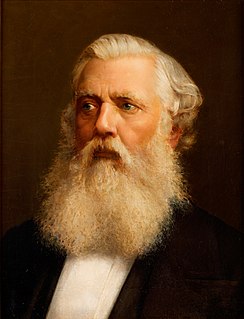
Sir Austen Henry Layard was an English Assyriologist, traveller, cuneiformist, art historian, draughtsman, collector, politician and diplomat. He was born to a mostly English family in Paris and largely raised in Italy. He is best known as the excavator of Nimrud and of Nineveh, where he uncovered a large proportion of the Assyrian palace reliefs known, and in 1851 the library of Ashurbanipal. Most of his finds are now in the British Museum. He made a large amount of money from his best-selling accounts of his excavations.

Catherine Greenaway was an English Victorian artist and writer, known for her children's book illustrations. She received her education in graphic design and art between 1858 and 1871 from the Finsbury School of Art, the South Kensington School of Art, the Heatherley School of Art and the Slade School of Fine Art. She began her career designing for the burgeoning holiday card market, producing Christmas and Valentine's cards. In 1879 wood-block engraver and printer, Edmund Evans, printed Under the Window, an instant best-seller, which established her reputation. Her collaboration with Evans continued throughout the 1880s and 1890s.
Unto This Last is an essay critical of economics by John Ruskin, first published between August and December 1860 in the monthly journal Cornhill Magazine in four articles.
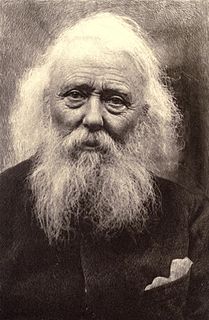
William James Linton was an English-born American wood-engraver, landscape painter, political reformer and author of memoirs, novels, poetry and non-fiction.

The Guild of St George is a charitable Education Trust, based in England but with a worldwide membership, which tries to uphold the values and put into practice the ideas of its founder, John Ruskin (1819–1900).

George Edmund Street, also known as G. E. Street, was an English architect, born at Woodford in Essex. Stylistically, Street was a leading practitioner of the Victorian Gothic Revival. Though mainly an ecclesiastical architect, he is perhaps best known as the designer of the Royal Courts of Justice on the Strand in London.

Sir Matthew Digby Wyatt was a British architect and art historian who became Secretary of the Great Exhibition, Surveyor of the East India Company and the first Slade Professor of Fine Art at the University of Cambridge. From 1855 until 1859 he was honorary secretary of the Royal Institute of British Architects, and in 1866 received the Royal Gold Medal.
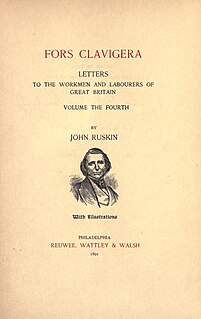
Fors Clavigera was the name given by John Ruskin to a series of letters addressed to British workmen during the 1870s. They were published in the form of pamphlets. The letters formed part of Ruskin's interest in moral intervention in the social issues of the day on the model of his mentor Thomas Carlyle.

Joseph Edward Southall RWS NEAC RBSA was an English painter associated with the Arts and Crafts movement.
Julia Mary Cartwright Ady was a British historian and art critic whose work focused on the Italian Renaissance.

Joanna Mary Boyce was a British painter associated with the Pre-Raphaelite Brotherhood. She is also known by her married name as Mrs. H.T. Wells, or as Joanna Mary Wells. She produced multiple works with historical themes, as well as portraits and sketches, and authored art criticism responding to her contemporaries. She was the sister of Pre-Raphaelite watercolourist George Price Boyce.
Sir William Bowes of Streatlam,, was an English ambassador to Scotland, Deputy Warden of the West March, Treasurer of Berwick-upon-Tweed, and Member of Parliament for Westmorland.
Ralph Nicholson Wornum (1812–1877) was a British artist, art historian and administrator. He was Keeper and Secretary of the National Gallery of London from 1855 until his death.

Ottaviano Nelli (1375–1444?) was an Italian painter of the early Quattrocento. Nelli primarily painted frescoes, but also panel paintings. He had several pupils and two painters were influenced by him.
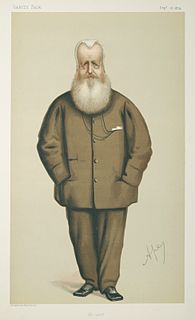
Sir James Hudson GCB was a British diplomat. He is noted for his time as British ambassador to Turin between 1852 and 1863, as an italophile and strong supporter of Italian unification, and a collector of Italian art.

The Palazzo or Ca' Cappello Layard is a palace situated in the sestiere of San Polo of Venice, Italy, overlooking the Grand Canal at the confluence between this and the smaller Rio di San Polo and Rio delle Erbe. On the Grand canal, it is located between Palazzo Barbarigo della Terrazza and Palazzo Grimani Marcello. It is particularly noteworthy for having been the residence of Austen Henry Layard, discoverer of Nineveh.
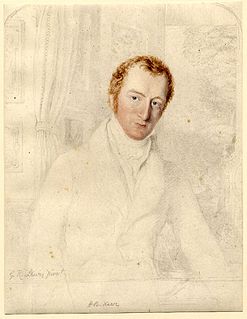
Charles Henry Bellenden Ker (c.1785–1871) was an English barrister and legal reformer.
Seymour Stocker Kirkup (1788–1880) was an English painter and antiquarian, resident in Italy from 1816.

The Ruskin Monument is a memorial to John Ruskin located on the edge of Derwentwater in the English Lakes at Friars' Crag, Keswick, Cumbria. It was erected on 6 October 1900, shortly after his death, largely through the efforts of Hardwicke Rawnsley.
References
Citations
- ↑ For example, relating to 1866, at page 210 of The Pre-Raphaelites, 1984 (exhibition catalogue, various authors), Tate Gallery, London, ISBN 0713916389
- ↑ Gregory. W. H. (April 1884). "The Arundel Society". The Nineteenth Century: 610–625.
- ↑ Barlow, Henry Clark (1870). "Aubrey Bezzi was a music master in Plymouth and became Eastlake's assistant secretary in the Royal Commission of Fine Arts". On the Vernon Dante. London: Williams and Norgate. pp. 36–37.
- ↑ Cook, E. T.; Wedderburn, Alexander, eds. (1908). The Complete Works of John Ruskin. Vol. Library Edition, Vol. XXXV, Praeterita and Dilecta. London: George Allen. p. 384.
Edmund Oldfield (1817-1902), M.A., F.S.A. ... assistant keeper of antiquities at the British Museum; and at one time private secretary to Layard at the Office of Works.
- ↑ "The fresco-paintings of Italy—the Arundel Society". Blackwood's Edinburgh Magazine. LXXXVIII (DXL): 458–471. Oct 1860.
- ↑ Cook, E. T.; Wedderburn, Alexander, eds. (1903). "The Complete Works of John Ruskin". Library Edition, Vol. IV, Modern Painters, Vol. II. London: George Allen: xliv.
{{cite journal}}: Cite journal requires|journal=(help) - ↑ A List of Members of the Society, Corrected to September, 1877. London: Arundel Society for Promoting the Knowledge of Art. 1877.
- ↑ Club, Arundel (20 May 2017). "The Arundel Club: For the Publication of Reproductions of Works of Art in Private Collections and Elsewhere". J.J. Waddington. Retrieved 20 May 2017– via Google Books.
Sources
- This article incorporates text from a publication now in the public domain: Gilman, D. C.; Peck, H. T.; Colby, F. M., eds. (1905). New International Encyclopedia (1st ed.). New York: Dodd, Mead.
{{cite encyclopedia}}: Missing or empty|title=(help)